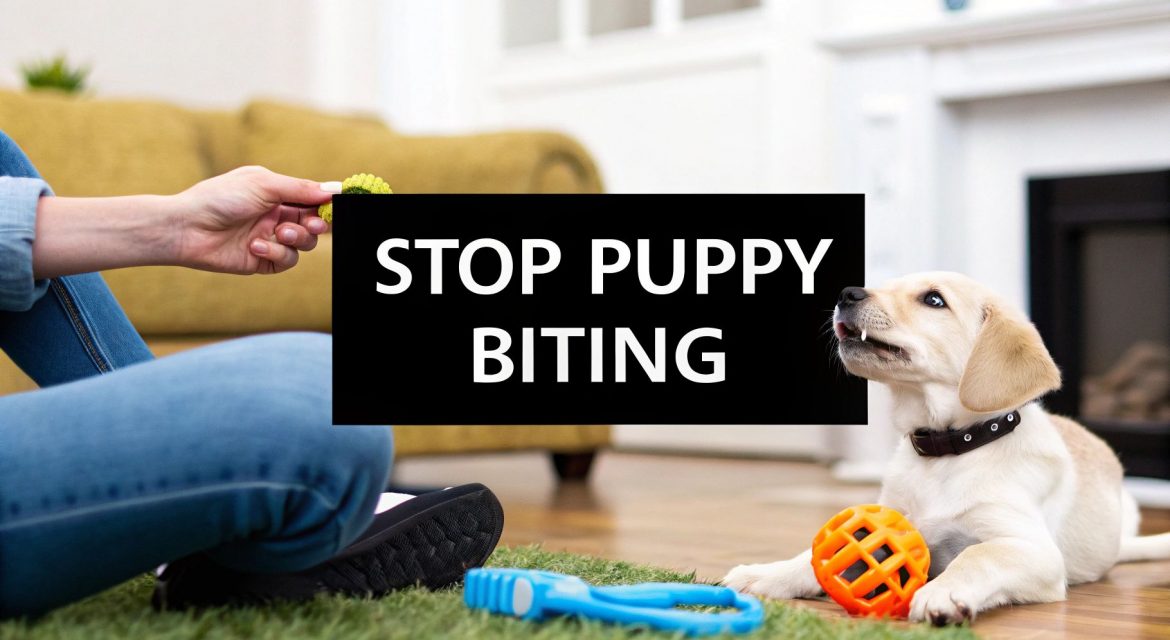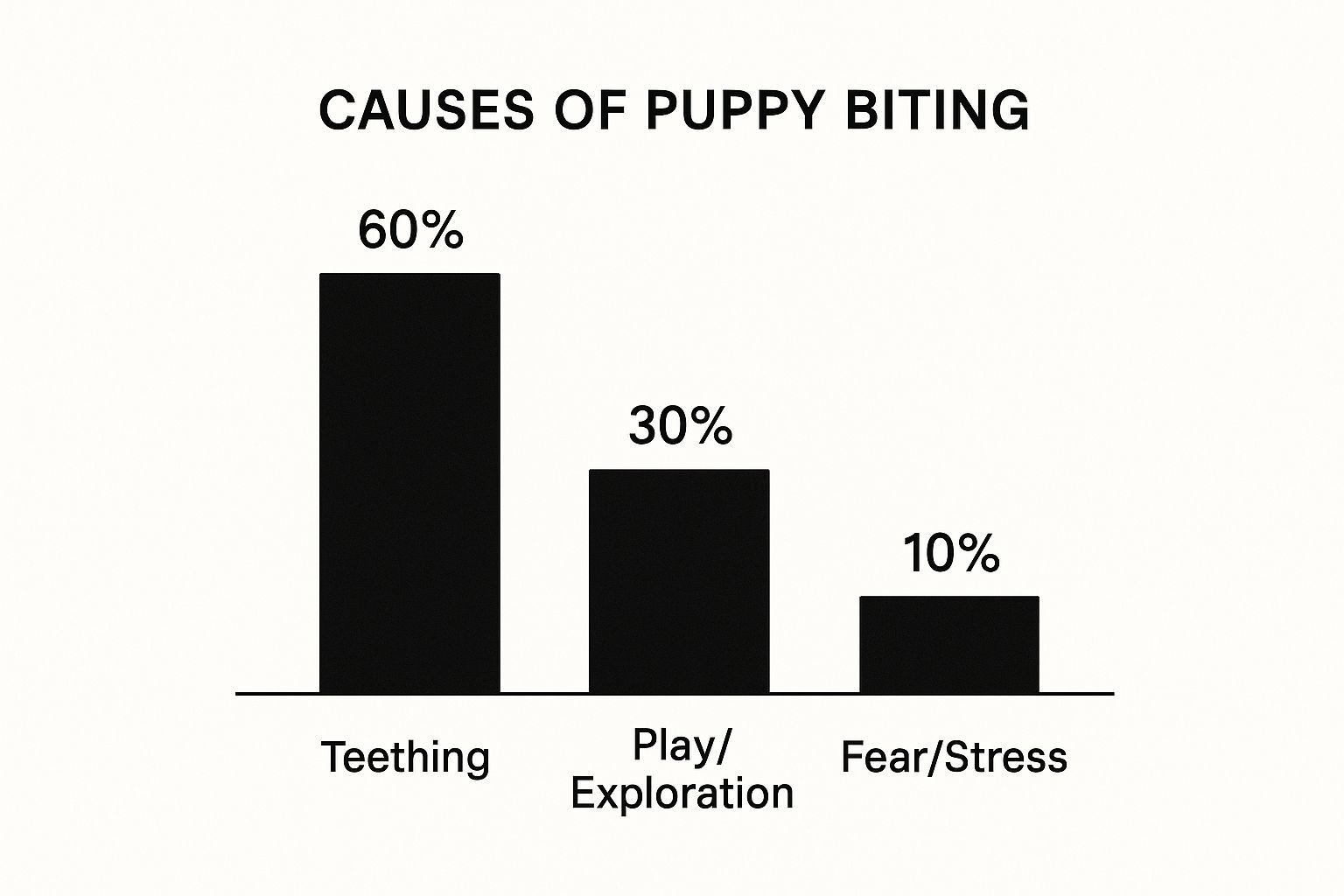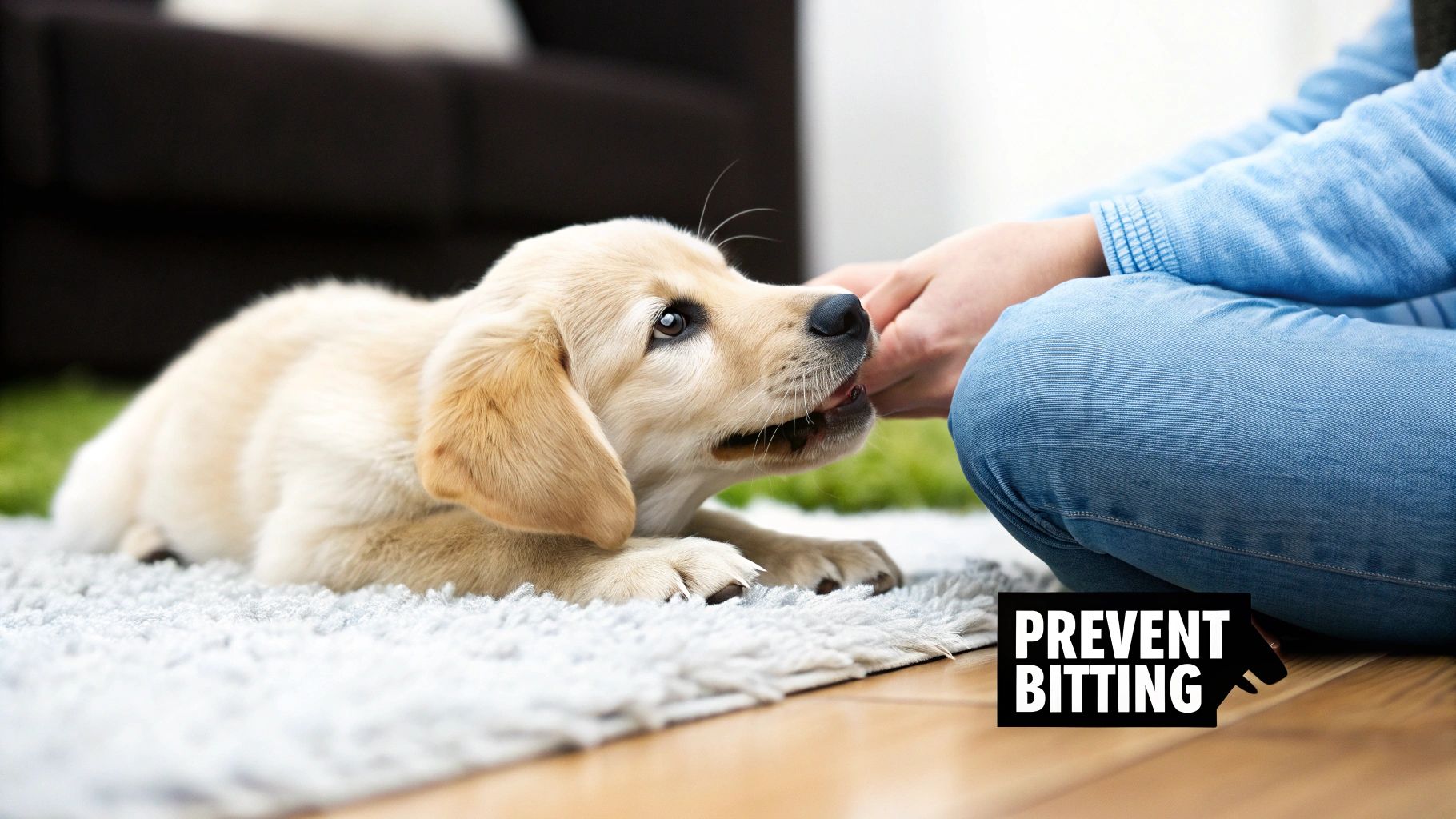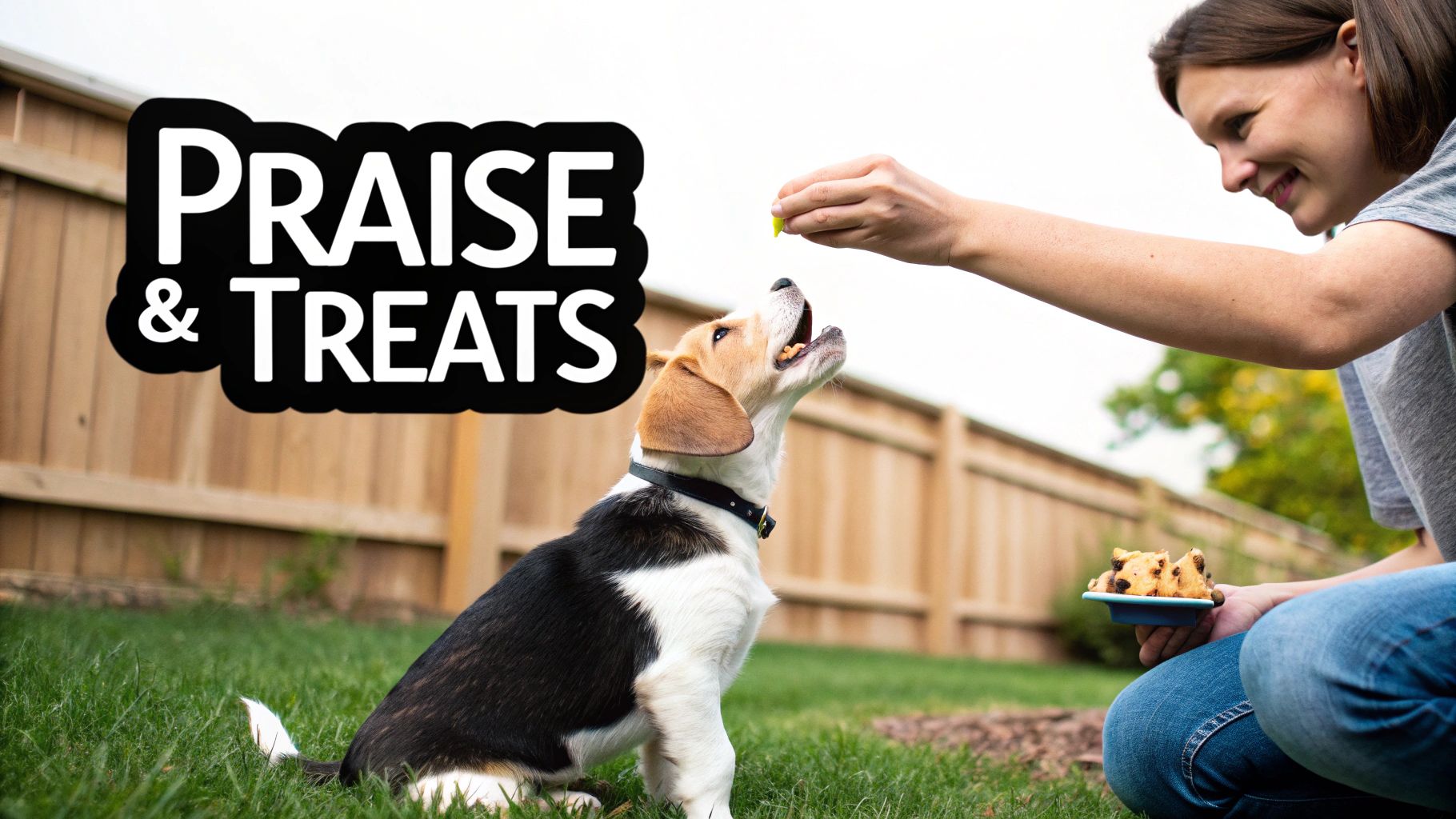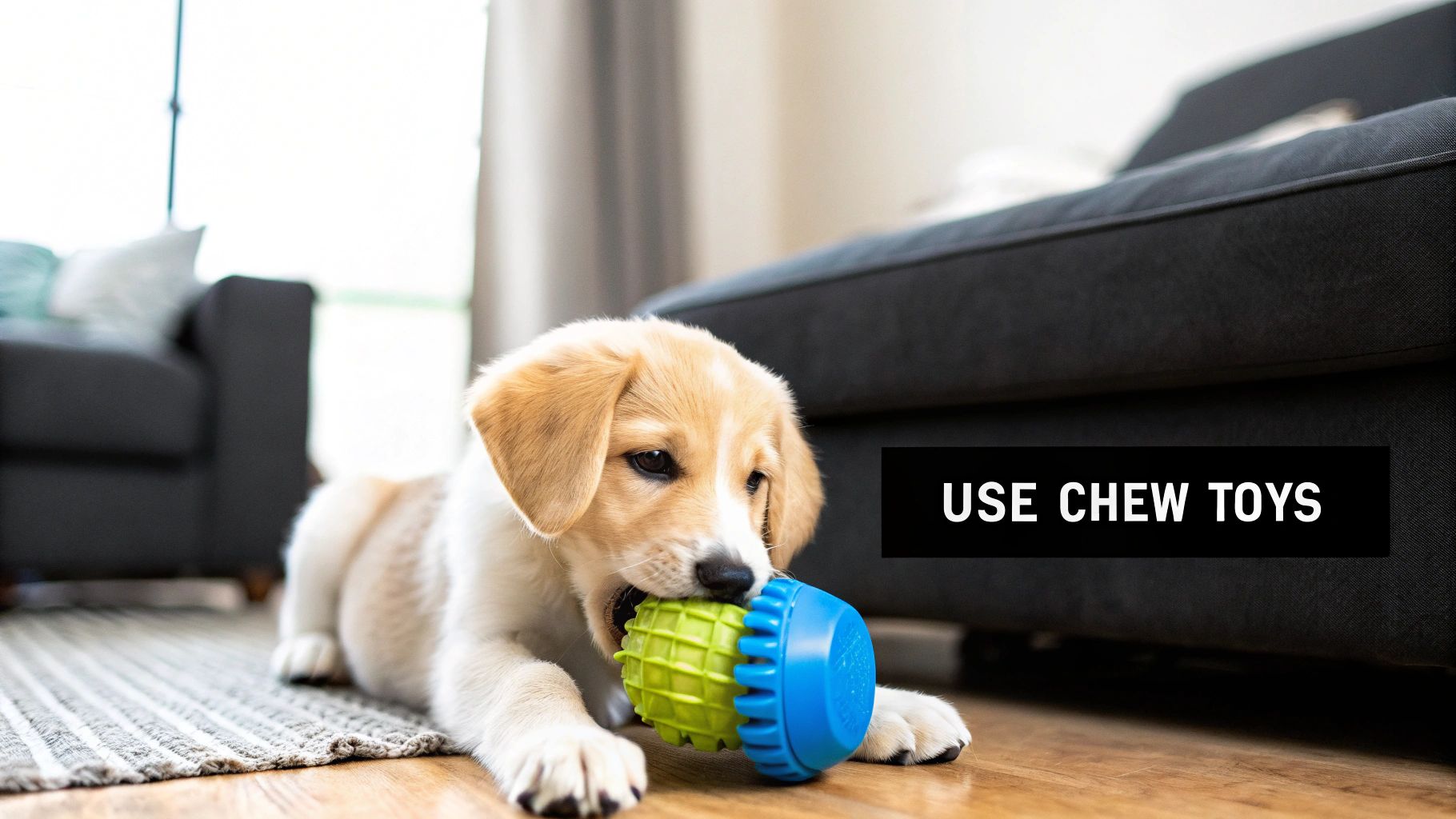So, you’ve welcomed a new puppy into your home. Congratulations! We know you’re soaking up all the cuddles and adorable moments, but you might also be nursing a few battle wounds on your fingers and wondering if your fluffy companion is secretly a tiny piranha.
Let us put your mind at ease: you’re not alone, and what you're seeing is completely normal. In fact, it's a vital part of how your puppy learns about their world.
For a young pup, their mouth is everything. It’s how they explore, much like a human toddler uses their hands to touch, grab, and understand everything around them. This isn't aggression; it's pure, unfiltered canine curiosity, and we're here to help you navigate it together.
The Main Reasons for Puppy Nipping
Those little nips and bites are your puppy’s way of communicating. They're trying to play, learn, and even find comfort. They are essentially practising behaviours they would have used with their littermates, where a sharp yelp from a sibling would have quickly taught them when a bite was too hard. Now that they're with you, that important job falls to you and your family.
Understanding what’s driving the behaviour is the first real step to managing it. The main culprits are usually:
- Teething Pain: Just like human babies, puppies get sore gums as their adult teeth push through. Chewing on things—including you—helps relieve that pressure.
- Play and Exploration: Puppies play-bite to kick off a bit of fun and figure out the social rules. It’s their version of wrestling and tumbling with their brothers and sisters.
- Learning Bite Inhibition: This one is crucial. Puppies need to learn how to control the pressure of their jaws. The only way they learn this is through feedback from you or other dogs.
This visual breaks down the most common reasons behind all that mouthing.
As you can see, the vast majority of nipping comes from a natural, developmental place, not a malicious one.
Why Early Training Is So Important
While it's a normal phase, it's absolutely vital to get a handle on it early on. In the UK, data reveals that around 70% of dog bites happen inside the home, often involving a family's own pet. This stark statistic really highlights why teaching your puppy appropriate mouth-manners from day one is non-negotiable, especially if you have young children.
By correctly managing these playful nips now, you're preventing them from escalating into more serious problems down the line. You can find more details on UK dog bite statistics and their implications on dogster.com.
Getting those initial responses right can make a world of difference. Here’s a quick-glance table to help you react effectively in the moment.
Quick Guide to Puppy Biting Responses
| Action | What to Do (The Right Way) | What to Avoid (The Common Mistakes) |
|---|---|---|
| Immediate Reaction | Yelp loudly ("Ouch!") and briefly withdraw your hand. | Pushing the puppy away or getting angry. This can seem like a fun game of rough-and-tumble to them. |
| Redirection | Immediately offer an appropriate chew toy. Praise them when they bite the toy instead of you. | Smacking their nose or holding their mouth shut. This can create fear and damage your bond. |
| Playtime Management | End the game for 30-60 seconds if the biting persists. This teaches them that biting stops the fun. | Allowing them to continue chewing on hands, even gently. This sends mixed signals. |
| Environment | Keep a variety of interesting chew toys readily available so there's always a better option than your fingers. | Leaving tempting but inappropriate items (like shoes or remote controls) within their reach. |
Think of this table as your initial playbook. Consistency is your best friend here—if everyone in the household responds the same way, your puppy will learn the rules much faster.
Teaching Bite Inhibition for a Softer Mouth
Feeling a bit like a human pin cushion thanks to those needle-sharp teeth? We’ve all been there. It's a completely normal part of puppyhood. But here’s the good news: our aim isn't to stop the mouthing altogether, at least not right away. Instead, we're going to teach your puppy a vital life skill called bite inhibition.
This is all about helping them understand and control the pressure of their jaw. It’s a lesson their mum and littermates would have started, and now it's our job to continue that education with a bit of patience and consistency.
Speaking Your Puppy’s Language
When puppies play together, a bite that lands too hard earns a sharp yelp from a sibling, bringing the game to an abrupt halt. This immediate cause-and-effect is exactly how they learn their own strength. We can mimic this natural process to get the same message across.
Next time you're playing and feel those teeth clamp down a little too firmly, let out a sharp, high-pitched "Ouch!" or "Yip!". You don't need to shout it angrily; the goal is to surprise them just enough to make them release their grip.
The moment you yelp, pull your hand away and give your puppy the cold shoulder for about 20-30 seconds. Turn your back, cross your arms, and look away. This short 'time-out' teaches a powerful lesson: hard bites make all the fun disappear.
A Key Takeaway: This isn't a punishment. It's clear communication in a language your puppy understands. You're showing them that their actions have direct consequences. For this to work, everyone in the family needs to be on the same page and react in the same way.
After the brief pause, you can invite them back to play. If they mouth you gently, brilliant! Give them some calm praise. If they bite hard again, just repeat the process. They'll gradually connect the dots: a soft mouth keeps the game going, while a hard one brings it to a screeching halt.
Common Scenarios and What to Do
Knowing how to react when your puppy bites often means reading the situation. What works for one pup might not for another, and context is everything.
Scenario 1: The "Ouch!" Just Makes Them More Excited
For some puppies, especially high-energy breeds, a yelp can have the opposite effect. Instead of backing off, they get even more wound up, thinking it's all part of the game.
- What to do: If this sounds familiar, ditch the yelp. Use a calm but firm "Too bad" or "Game over" instead. The key is to immediately stand up and walk away, ending playtime for a minute or two. The withdrawal of your attention is the real teacher here, not the noise.
Scenario 2: The Over-Enthusiastic Tug-of-War Biter
Tug-of-war is a fantastic game, but it can quickly escalate. In the heat of the moment, it's easy for an over-aroused puppy's teeth to accidentally find your hands.
- What to do: Set clear rules from the very beginning. Teach a solid "drop it" command. If their teeth ever touch your skin, even by accident, the game stops instantly. Say your cue ("Game over"), have them release the toy, and walk away. This constantly reinforces that human skin is always off-limits.
Managing these behaviours becomes a lot easier when your puppy has a safe, comfy space to go to when they need to decompress. A designated 'calm down' zone is a true game-changer. If you're just getting started with this, our guide on how to crate train a puppy offers a gentle and effective approach.
Redirecting Chewing to Appropriate Toys
A puppy's need to chew is a powerful, hard-wired instinct. Just telling them 'no' when they start gnawing on you is a bit like telling water not to be wet—it rarely works because it doesn't give them an alternative for that natural urge. We're not trying to eliminate the chewing; we just want to change the target. This is where redirection becomes your most valuable tool. It’s all about showing your puppy what they can chew on, rather than just what they can’t.
Think of it as a positive swap. The second your puppy’s mouth finds its way to your hand or the hem of your trousers, you need to swoop in with something far more interesting. This means being prepared. We always tell our clients to have an approved chew toy within arm's reach, whether you're on the sofa watching telly or working at your desk. The real secret is anticipating the bite before it happens and offering the toy first.
Making Toys More Exciting Than You
Of course, the challenge is making a rubber toy seem more appealing than a warm, moving hand. This is where you have to put on a bit of a performance. Simply dropping a toy in front of your pup and hoping for the best just won't cut it. You’ve got to sell it.
When you redirect, make that toy come alive. Wiggle it, drag it along the floor like it’s escaping, and use a high-pitched, playful tone of voice. "Ooh, what's this? Get your toy!" The moment your puppy latches onto the toy instead of you, shower them with praise. Make a real fuss. This teaches them a brilliant lesson: biting people stops the fun, but biting toys earns attention and praise.
This simple switch from 'don't do that' to 'do this instead' is the very foundation of effective, positive puppy training. You're not just correcting a behaviour; you’re teaching a better alternative, which builds trust and strengthens your bond.
Building Your Puppy’s Toy Box
Variety is absolutely key to keeping your puppy engaged and their teeth off you. One lonely toy will get boring fast. Aim for a good selection of different textures and types to figure out what your pup really loves.
Here are a few essentials to have on hand:
- Soft Rubber Toys: These are perfect for general chewing, especially for younger pups whose adult teeth haven't fully emerged.
- Hard Nylon Toys: Much more durable and satisfying for those pups with stronger jaws or a more determined chewing style.
- Rope Toys: Brilliant for a supervised game of tug, which is a fantastic way to bond and burn off some of that puppy energy.
- Puzzle Toys: These get your puppy's brain working by making them problem-solve for a treat. They provide crucial mental stimulation.
For teething puppies, a cold toy can be incredibly soothing for their sore gums. Just pop a rubber chew toy in the freezer for a bit before giving it to them. The cold helps to numb the discomfort, making it a highly desirable alternative to your ankle. By rotating their toys every few days, you keep things feeling new and exciting, ensuring there's always an appropriate option for them to focus on.
Creating a Puppy-Proof Environment for Success
Sometimes, the most effective training doesn't feel like training at all. It’s all about setting up your home to prevent unwanted behaviour before it even has a chance to start. This is especially true when you're dealing with a nippy puppy. By managing your pup's environment, you make your life much easier and set them up to succeed.
We've all been there. You turn your back for a split second, and your brand-new trainers have become a chew toy, or an electric cable suddenly looks like the most fascinating game. This is where puppy-proofing becomes your secret weapon. It isn't about restricting your puppy; it's about keeping them safe and dramatically reducing the number of times you have to say "no".
Using simple tools like baby gates and playpens allows you to create designated "puppy-safe zones." Think of these as areas where your puppy can play freely without access to tempting—but dangerous or valuable—items. This isn't a crutch; it's a smart management strategy that gives both of you some much-needed peace of mind.
The Power of a Predictable Routine
Beyond managing their physical space, managing your puppy’s time is just as crucial. A tired, overstimulated puppy is almost always a nippy puppy. This is where a consistent daily routine becomes one of your most powerful allies in your mission to stop the biting. Puppies thrive on predictability; it helps them feel secure and understand what's expected of them.
When a puppy’s core needs for play, rest, and mental stimulation are reliably met, their tendency to bite out of boredom or frustration plummets. A structured day helps prevent that dreaded "puppy witching hour" when an overtired pup transforms into a tiny, furry terror.
Your schedule doesn't need to be rigid down to the minute, but a general flow to the day works wonders. Think of it as a rhythm that balances high-energy activities with essential downtime.
Key Insight: A consistent routine is preventative medicine for bad behaviour. By anticipating your puppy's needs for food, potty breaks, play, and sleep, you are proactively solving problems before they arise. It’s the ultimate form of proactive puppy parenting.
A Sample Daily Puppy Schedule
To help you get started, here’s a simple template. Remember to adjust this based on your own schedule and your puppy’s individual energy levels and age.
- Morning (7:00 – 9:00 AM): Potty break first thing, followed by breakfast. A short play or training session (5-10 minutes) comes next, then another potty break before you settle them down for a nap in their crate or playpen.
- Mid-Day (12:00 – 2:00 PM): Wake up, potty break, and lunch. This is a great time for some calm enrichment, like a puzzle toy, followed by another potty break and then more nap time.
- Afternoon (4:00 – 6:00 PM): Potty break as soon as they wake up. Now is a good time for a walk or a more active play session in the garden. Puppies often have a burst of energy around now, so it’s the perfect time to burn some of it off positively.
- Evening (8:00 – 10:00 PM): Dinner, followed by some quiet cuddle time or gentle play. Avoid high-energy games right before bed to help them wind down. A final potty break is a must, then it's bedtime in their crate for the night.
This structured approach significantly reduces stress for everyone, creating a calm, predictable home where your puppy can learn and grow—with their teeth on their toys, not on you.
Troubleshooting When The Biting Continues
So, you've been consistent with your yelps, you’re a master of redirecting those sharp teeth onto a toy, and your home is practically overflowing with chew things. And yet… the biting carries on, maybe even getting a little more intense. First things first: take a deep breath. You haven't failed. This is a very common, and frankly, very frustrating hurdle for so many new puppy owners.
Sometimes, the standard techniques don't seem to cut it because there’s something else going on under the surface that needs a bit of attention. Realising you might need to dig deeper isn't a sign of defeat—it's the mark of a caring and responsible owner. Let’s figure out what might be happening and what to do next.
Looking Beyond Basic Puppy Mouthing
If the biting feels frantic, relentless, or always seems to happen in specific situations, it could be more than just typical puppy mouthing. Let's look at a few common culprits that can keep those little land-shark moments going.
- Over-Arousal and Overtiredness: Just like a toddler who misses a nap, an overstimulated or overtired puppy completely loses their impulse control. This often leads to a "witching hour" of frantic, hard biting that seems to appear from nowhere.
- A Lack of Mental Stimulation: Physical exercise is crucial, but a bored brain is a mischievous one. If your pup isn't getting enough mental enrichment from puzzle toys, training games, or just sniffing around, they'll invent their own fun—and that often involves biting you.
- Fear or Anxiety: Sometimes, the biting isn't playful at all. It can be a reaction to something scary. A puppy who hasn't been properly socialised might bite if they feel cornered, are startled, or are unsure about new people or dogs.
This is one of the most important things to remember: feeling overwhelmed is normal. Many owners feel like their lives have been turned upside down and worry they've made a mistake. You are absolutely not alone in feeling this way, and it often gets better with time and the right support.
The Critical Role Of Owner Education
Understanding your puppy’s behaviour is everything. Recent UK statistics show that just relying on breed-specific rules doesn’t solve the problem of dog bites. In fact, since the introduction of the Dangerous Dogs Act, dog bite fatalities have unfortunately risen, which strongly suggests that owner responsibility and early training are far more critical factors.
Interestingly, the data shows adults aged 50-59 are more likely to be hospitalised for dog bites than children are, challenging the old stereotypes about who is most at risk. This just goes to show how vital it is for everyone to understand how to stop puppy biting through consistent, positive training from day one. You can read more about these surprising dog bite statistics on pets4homes.co.uk.
Knowing When To Call For Professional Help
If you have a gut feeling that the biting is getting worse or might be coming from a place of fear, it's time to call in a professional. Honestly, this is the strongest and most loving decision you can make for your puppy.
Look for a certified professional dog trainer or a veterinary behaviourist. They can create a personalised plan that fits your puppy's unique needs, and their guidance is almost always built on rewarding good choices. A qualified expert can properly assess your pup, get to the root cause of the biting, and give you the specific tools and confidence needed to move forward successfully.
Your Questions About Puppy Biting Answered
Even with a solid plan, raising a puppy is full of little moments that can leave you scratching your head. It’s a real rollercoaster, and it's totally normal to need a bit more clarity now and then. You’re definitely not alone in this!
We've pulled together some of the most common questions we get from new puppy owners, just like you. Think of this as your go-to guide for those "what if" scenarios, helping you feel confident and prepared.
Why Does My Puppy Bite My Ankles When I Walk?
Oh, the ankle-biting phase! This is classic puppy behaviour, and it's almost always driven by instinct. When your feet and ankles are moving, they trigger your puppy's natural prey drive. To your little one, those flapping trouser legs are an irresistible target that practically begs to be chased and pounced on.
It’s not aggression; it's just a misplaced attempt at a game. The best thing you can do is freeze the moment it happens. A still target is a boring target. Then, immediately get their attention onto something they can bite, like a toy you can wiggle to make it exciting. A moving toy is always a better choice than a foot that has suddenly stopped being fun.
Is It True Some Breeds Bite More Than Others?
This is a common myth. While some breeds certainly have a stronger genetic pull towards behaviours like herding or guarding, any puppy of any breed can become a biter if they aren't taught good manners. Honestly, how you train and socialise them is far more important than their pedigree.
Getting hung up on breed stereotypes can be really misleading. We’ve seen beautifully trained German Shepherds with softer mouths than poorly socialised Labradors. The core principles of teaching bite inhibition, redirection, and managing their environment apply to every single puppy. It's your consistency that shapes their behaviour, not their breed.
A Critical Reminder: Please don't underestimate how important early training is. When nipping isn't addressed, it can lead to serious problems down the line. Between 2020 and 2021 in England, over 7,400 people needed hospital treatment for dog bites, with many requiring surgery. This sobering fact from UK dog bite statistics from hepper.com really highlights why teaching your puppy not to bite is a crucial responsibility for every owner.
Will My Puppy Ever Grow Out Of Biting?
Yes… and no. Most puppies will naturally outgrow that frantic, constant need to mouth everything once their adult teeth have settled in, which usually happens around six to eight months old. So, the intense teething-related chewing will definitely fade.
But, and this is a big but, they will not outgrow biting if they've learned it's a useful behaviour. If your puppy figures out that a quick nip gets them attention or is a fun way to start a game, they’ll carry that right into adulthood. That’s why your work now is so important—you're teaching them manners that will last a lifetime.
When Is Biting a Sign of Real Aggression?
It's rare in very young puppies, but it’s vital to recognise the difference. Playful nipping is usually "bouncy" and comes with relaxed body language—think play bows or a happy, wagging tail. The bite itself might be a bit too hard, but there’s no real malice behind it.
Aggressive biting, on the other hand, looks and feels completely different. You need to be on the lookout for these warning signs:
- Stiff Body Language: A tense, frozen body is a major red flag.
- Growling or Snarling: That low, guttural growl is a clear "back off" signal.
- Lip Curling: When they pull back their lips to show their teeth, it isn't play.
- Hard Stare: An intense, unwavering stare can be a direct challenge.
If you see these behaviours, especially more than one at a time, it’s time to get help from a professional trainer or behaviourist. This is also where early socialisation makes a huge difference. You might find our guide on how to socialize a puppy helpful for building their confidence and preventing fear-based reactions.
At My Life My Dog, we're here to support you through every stage of your dog ownership journey, from puppyhood problems to golden-year joys. For more expert guides and tips, explore https://mylifemydog.com.


